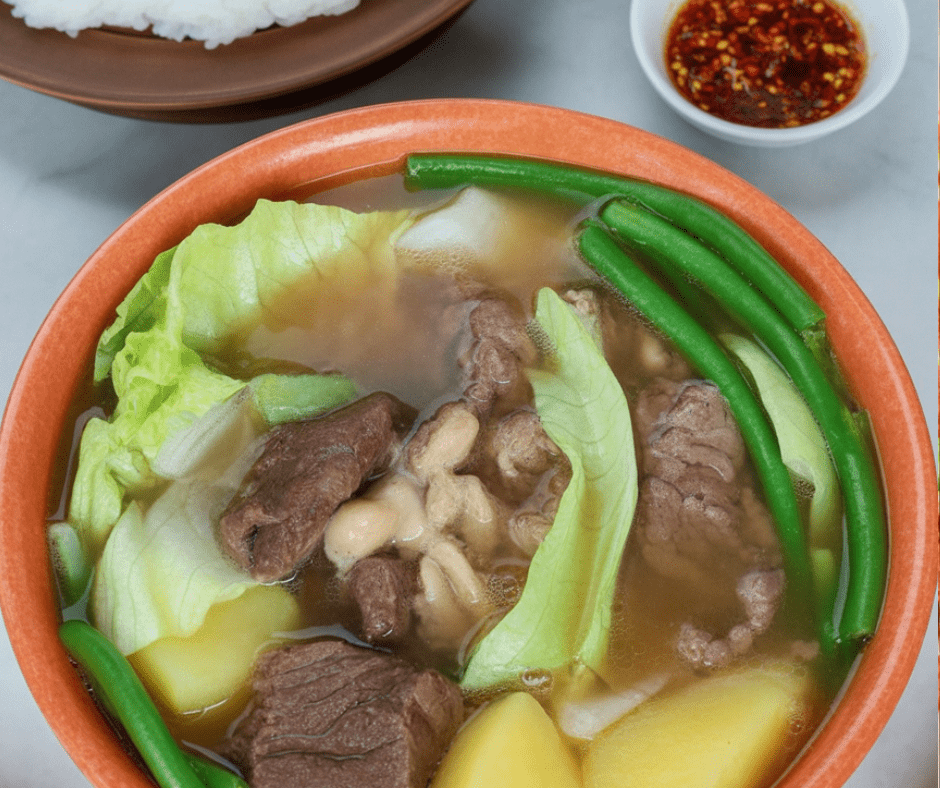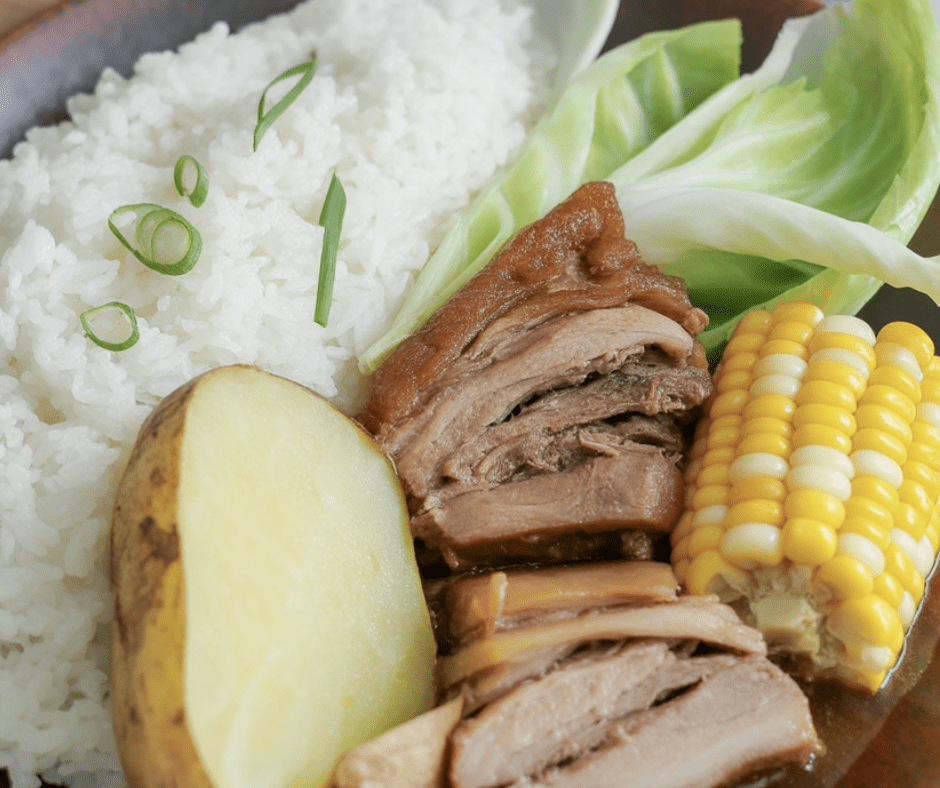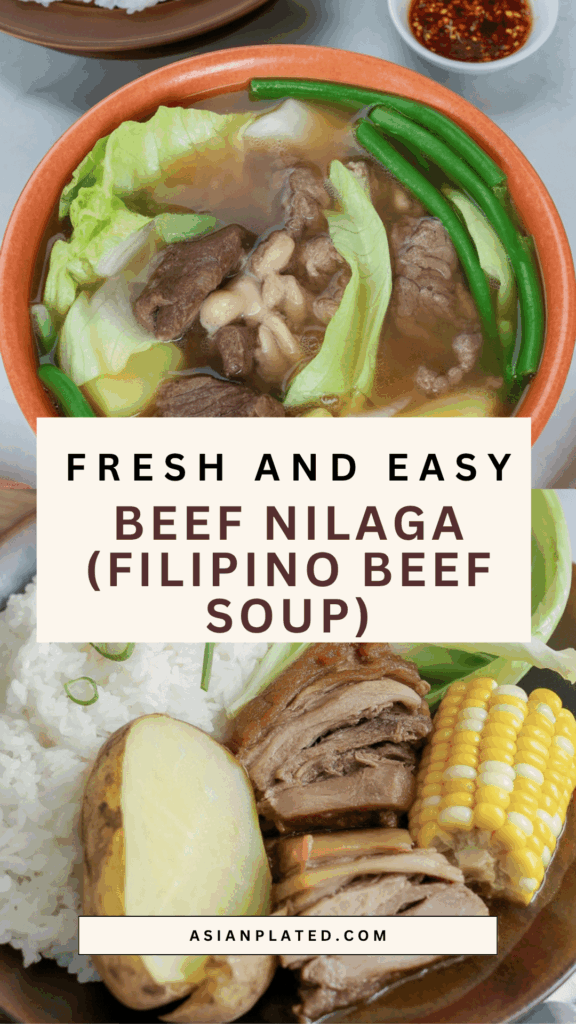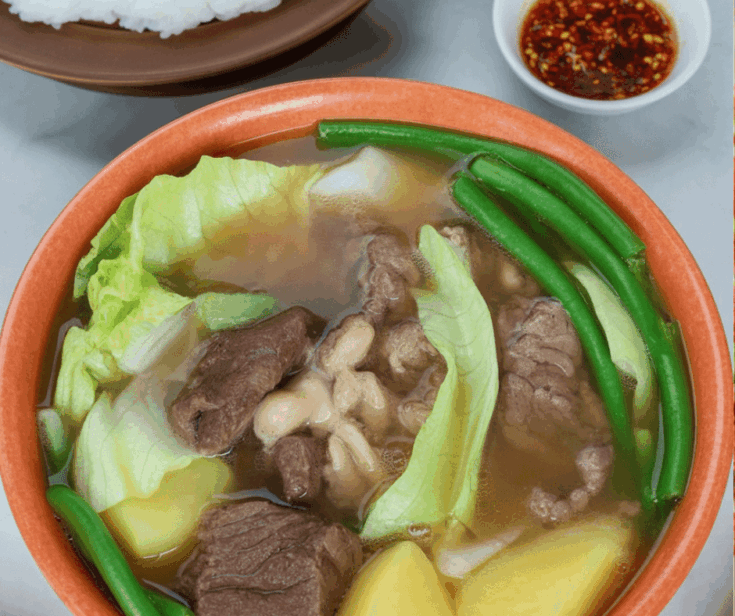There’s something incredibly comforting about a big bowl of Nilagang Baka—especially when the skies turn gray and the rain starts pouring. This classic Filipino beef soup is slow-simmered with love, packed with tender beef shanks, chewy tendon, and a medley of vegetables that soak up all that rich, flavorful broth. It’s the kind of meal that warms you from the inside out, perfect for cozy Sundays or those days when you just need a little comfort in a bowl.

What is Nilaga
Nilaga simply means “boiled” in Filipino, and that’s exactly what this dish is—meat gently simmered in broth with vegetables until everything is fall-apart tender and full of flavor. While you can make it with pork or even chicken, beef nilaga is the most iconic version.
The soup starts with basic aromatics like onions, whole peppercorns, and a splash of fish sauce. Then you add hearty ingredients like potatoes, corn on the cob, cabbage, green beans, and carrots. It’s simple, rustic cooking, but incredibly satisfying. It’s also deeply rooted in Filipino households—something we often make on a rainy day, or during Sunday family lunches.
Beef Cuts That Make the Best Nilaga
For the best-tasting broth, go for cuts that are rich in connective tissue. Beef shanks and tendons are top choices—they break down beautifully with long, slow cooking and give the soup that lip-smacking richness.
Other great options? Brisket, beef chuck, short ribs, or even neck bones. These aren’t your fancy steak cuts, but that’s the point—they’re budget-friendly and full of flavor, especially when given time to simmer.
Making the Broth Clean and Clear
Here’s the deal with a good nilaga—the broth should be clear but rich. During the first few minutes of boiling, foam and impurities will float to the top. Skim this off as it appears. Once the froth stops forming, lower the heat and let it simmer gently. No rapid boiling from here on—just slow cooking.
If you want an extra-clear broth (and a cleaner taste), take the time to blanch the meat first. It’s a little extra effort, but well worth it.
How to Blanch the Meat
- Add your beef pieces to a pot of cold water, making sure they’re completely submerged.
- Bring it to a boil and start skimming off the scum that rises.
- Once the water is cloudy and you’ve skimmed all you can, drain the pot.
- Rinse both the meat and the pot, then refill with fresh water and start the actual cooking.
This step helps remove blood and other impurities that can make the broth murky.
A Quick Tip About Tendons
Beef tendons can be tricky—they’re nearly impossible to slice when raw. Either ask your butcher to chop them into pieces for you, or wait until they’ve softened partway through cooking. At that point, you can pull them out, slice them easily, and return them to the pot to finish cooking. Easy!

How to Serve Nilagang Baka
Traditionally, Nilagang Baka is served with a big bowl of white rice and a side of patis (fish sauce) for dipping. The meat and veggies go on the plate, the broth gets its own little bowl or mug, and everyone digs in.
It’s a meal in itself, but that extra broth on the side? It’s pure comfort, especially if you sip it between bites of rice and meat.

Storing Leftovers
Got leftovers? Lucky you—nilaga tastes even better the next day.
- Fridge: Store in an airtight container and keep for up to 3 days.
- Freezer: It also freezes beautifully for up to 2 months.
- To Reheat: Gently warm it on the stovetop over medium heat until hot. You can also microwave it in short intervals, stirring in between, until it’s heated through.
Beef Nilaga (Filipino Beef Soup)

Beef Nilaga is the ultimate Filipino comfort soup! Packed with tender beef shanks, melt-in-your-mouth tendon, and hearty vegetables, this dish is both filling and flavorful.
Ingredients
- 2 tablespoons fish sauce
- 3 ears of corn, husked and halved
- 2 medium potatoes, peeled and quartered
- 1 small cabbage, sliced into wedges
- 12 green beans, ends trimmed
- salt to taste
- green onions, for garnish (optional)
- 2 pounds beef shanks, bone-in
- 1 pound beef tendons
- 8 cups water
- 1 large onion, peeled and cut into quarters
- 1 teaspoon whole peppercorns
Instructions
- n a large pot, combine the beef shanks, beef tendons, and water. Bring to a boil over medium heat, skimming off any scum that rises to the surface.
- Once the broth is clear, stir in the onions, peppercorns, and fish sauce.
- Reduce the heat to low, cover the pot, and simmer gently for 2 to 2 ½ hours, or until the beef is fork-tender and tendons are soft. Add more water if needed to maintain 6 to 7 cups of broth.
- Add the corn and simmer for another 5 to 7 minutes.
- Add the potatoes and cook for around 5 minutes, or until nearly tender.
- Stir in the green beans and cabbage. Let cook for 2 to 4 minutes more, or until the vegetables are just tender but still crisp.
- Season with salt as needed. Ladle into bowls, top with chopped green onions if desired, and serve piping hot.
Notes
- Beef tendons are extremely tough when raw, making them hard to slice. It’s best to ask your butcher to cut them ahead of time.
- Alternatively, once they begin to soften during cooking, remove them briefly from the pot, cut into serving pieces, and return them to finish cooking with the rest of the soup.
Nutrition Information:
Yield: 6 Serving Size: 1Amount Per Serving: Calories: 698Total Fat: 24gSaturated Fat: 9gTrans Fat: 0gUnsaturated Fat: 12gCholesterol: 184mgSodium: 727mgCarbohydrates: 44gFiber: 11gSugar: 14gProtein: 79g
Asianplated.com, occasionally offers nutritional information for recipes contained on this site. This information is provided as a courtesy and is an estimate only. This information comes from online calculators. Although allchickenrecipes.com attempts to provide accurate nutritional information, these figures are only estimates.
FAQs
Can I use a pressure cooker to make this faster?
Yes! You can cut down cooking time significantly by using a pressure cooker or Instant Pot. Just be sure to still skim the scum if you’re not blanching first.
Can I skip the tendon?
Absolutely. It adds great texture and richness, but if it’s not your thing or hard to find, just double up on shank or use chuck roast.
What vegetables can I add?
Cabbage, potatoes, carrots, green beans, and corn are classic. You can also use pechay (Filipino bok choy), napa cabbage, or even saba bananas for a touch of sweetness.
What can I serve with this?
Aside from rice, try a side of sawsawan (a dipping sauce of fish sauce with calamansi or lemon and chilies). It really brightens up the dish.
Try other filipino recipes:
